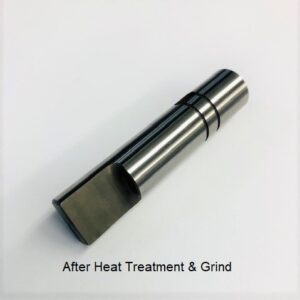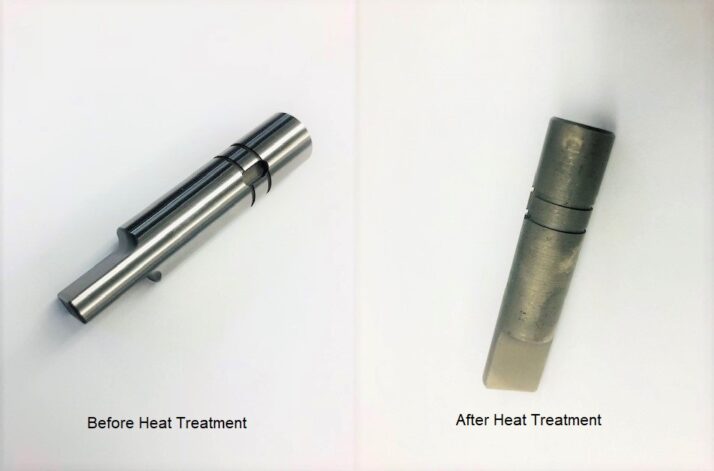Heat treating a precision machined component is a controlled heating and cooling process that alters the physical properties of the metal to achieve a specific requirement. In many cases, heat treatment is used to increase strength, hardness, and wear resistance. However, depending on the material and process involved, it can also be used to relieve internal stress, improve machinability, and improve electrical or magnetic properties, or increase ductility and softness.
The heat-treating process involves 3 basic steps:
- Heating: the metal is heated to a specific temperature where the structural properties will change.
- Soaking: the metal is maintained at the specified temperature until the entire part has been heated evenly.
- Cooling: the metal is cooled back to room temperature at a specified rate.
Heating treating is used primarily on steels and steel alloys but can also be used on some grades of aluminum. Pioneer Service has experience machining and heat treating a wide variety of steel alloys and carbon steel material to meet project requirements.
There are 4 basic types of heat treating for steel:
- Hardening: as its name suggests, this process is used to harden the material and make it stronger. However, with this process, the material will also decrease in ductility (ie becoming more brittle) and depending on the application, create the need for tempering after hardening.
For parts that require hardening, the material is heated to a high temperature slowly, soaked a particular temperature for a specified time and then cooled quickly by plunging them into water or oil. This rapid cooling in a liquid is called quenching.
For carbon steel, the steel must be cooled to under 1000 degree Fahrenheit in less than 1 second. For alloyed steels, the cooling rate will decrease.
- Tempering: Hardening a material increases internal stresses and tempering will relieve those stresses. The material will go through a similar 3 steps process at hardening, although it is done at lower temperatures. The cooling process for tempering is almost always done in air and not a liquid.
- Annealing: Annealing is often used to increase ductility of the materials (making the metal less likely to crack), to relieve stress, or soften the metal. It is generally considered the opposite of hardening. In this process, the metal is heated very slowly to a specified temperature, held there for a specified amount of time (soaking), and then air cooled slowly- usually by leaving the parts in the furnace as it cools down normally. With low-carbon steels, the temperature for annealing is high, and as the carbon level increases, the temperature for annealing will decrease.
- Normalizing: This process is used to relieve internal stresses that were created during machining. For normalizing, the parts will be removed from the furnace for air cooling after the heating and soaking stage. Removal from the furnace will cause the parts to cool at a faster rate – although the mass of the parts will affect that rate (smaller and thinner parts will cool faster that larger thicker ones). Normalized steel is stronger than annealed steel.
While there are many metal properties that can be improved by heat treating, the process can have some adverse effects on the surface of the part.
- Scale on the surface of the component – affecting the surface finish
- Distortion of the part – some long thin parts will bend or distort in the heat treating process
- Coloring of the part – the heat treatment process will darken the material and it will no longer be shiny like it was after machining.
The parts may be able to be straightened after heat treatment to eliminate the distortion, and grinding is usually possible to attain a required consistent surface finish. However, the color of the part can rarely be returned to the state is was before heat treatment. Here is the same component pictured after heat treatment and grinding:

Pioneer Service manufactures a wide variety of custom steel turned components for clients in the medical, aerospace, oil and gas, lawn and garden, electric vehicle and a wide range of additional industries. We work with many qualified heat treating partners, depending the volume of parts needed and the specified requirements for the processing. If your project requires a precision turned component with heat treatment, contact our Sales and Engineering team today so we can provide you with a quote. We are also happy to answer any questions about our capabilities and experience. For more information about other finishing services that Pioneer Service can provide for precision turned components, please see our Finishing Services page.



